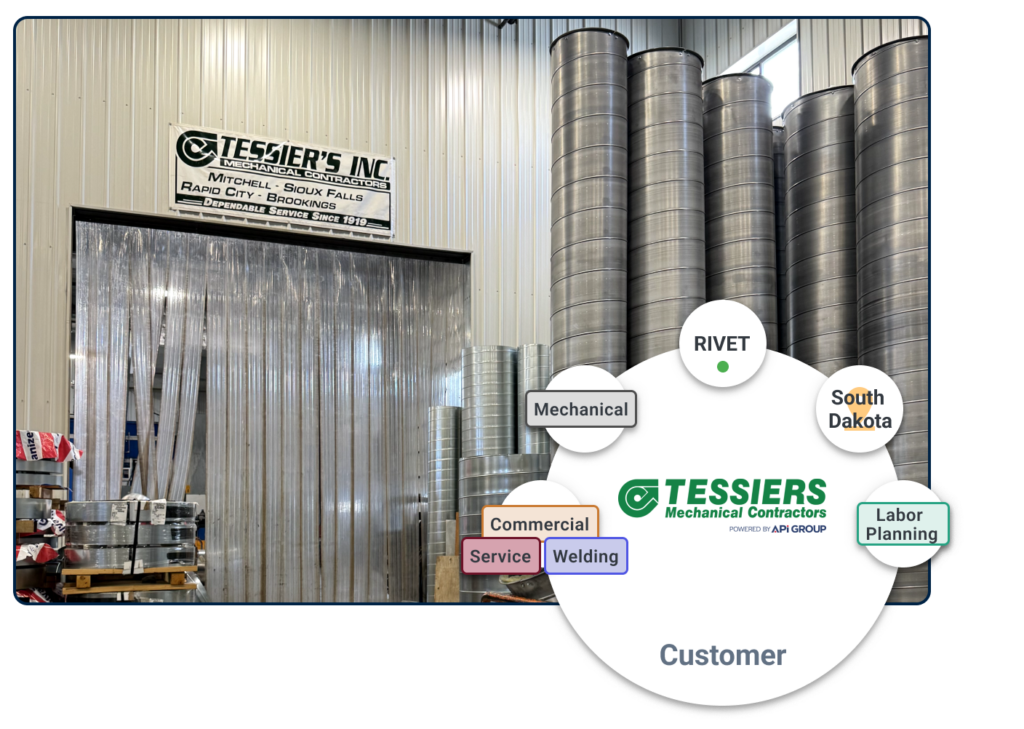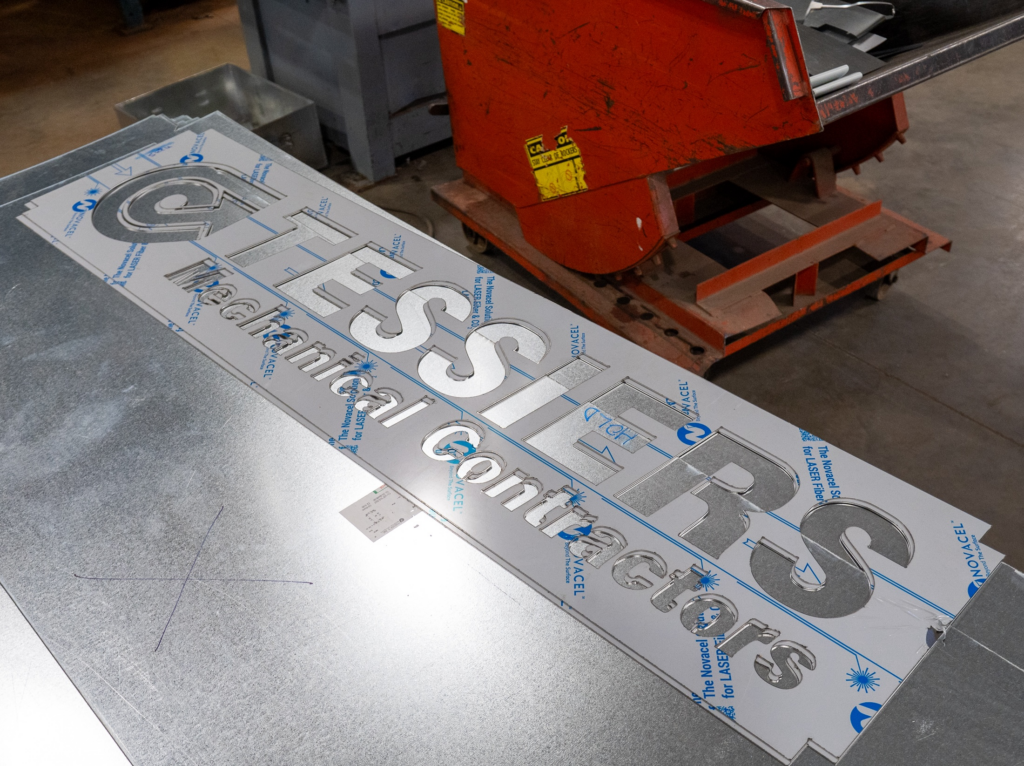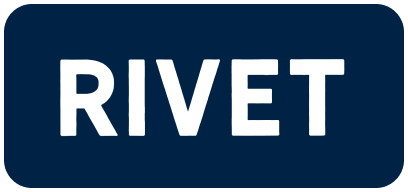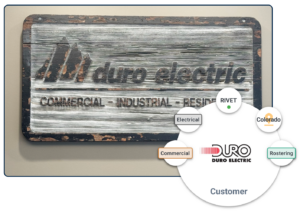Labor Planning at Tessiers Mechanical Contractors bolsters Productivity
“We’ve been 10:1 in profit gain to profit fade on jobs. A lot of that comes from our labor savings.”
Bill DeNet
Vice President

Start today.
Adopting the RIVET Workforce Management Platform can have a huge impact on your field productivity and profitability.
The Tessiers team’s insights for other contractors
- “We have to be responsible with [labor] so we’re not over-allocating resources and essentially running people out the door because we’re grinding them into dirt.”– Bill DeNet, Tessiers Vice President
“The PMs are highly involved in manpower, it’s not just me or [Bill] anymore.” — Shawn Kast, Tessiers Operations Leader
Tessiers Mechanical Contractors can control two things on any given job: labor and materials. The unfortunate truth is that labor is one of the biggest liabilities on any project, too. For example, 10 years ago a 1:1 profit fade to profit margin ratio was common.
“We saw a lot of that was due to labor,” Vice President Bill DeNet said. Faced with that reality, Tessiers made a decision.
“Why not implement a platform like RIVET?” DeNet asked. “[Labor] is our greatest area of opportunity.”
After prioritizing a Workforce Management platform and doubling down on process discipline, Tessiers has seen a massive shift in job profitability and Labor Productivity.
“We were 1:1,” DeNet said. “The past four to five years, we’ve been 10:1 in profit gain to profit fade on jobs. A lot of that comes from our labor savings.”
Tessiers has been kicking around South Dakota for 105 years. The company has worked everywhere from Texas to Oregon and all over the Midwest, lots of it hospitals and manufacturing facilities. To support that footprint, it has a handful of offices spread across the region.
Sioux Falls is home, and, with the exception of the Rapid City location near South Dakota’s Western border, its other shops are an hour’s drive away, give or take: Mitchell, Brookings and, across the Eastern border in Iowa, Sioux City.
Watch the Tessiers leadership team video interview here:
Advanced labor operations requires a platform
Effectively and efficiently managing labor with one office is a challenge for most contractors. With a distributed workforce like Tessiers, keeping tabs on everything would be impossible without a Workforce Management platform built for self-perform contractors. RIVET empowers the team’s project managers to collaborate across their disparate locations, and head off labor shortcomings earlier.
“You’re seeing it before it ever gets to the platform,” Operations Lead Shawn Kast said. In turn, this means Productivity killers aren’t as much of a factor anymore. “Guys have adjusted their Forecast and, by using their true actuals, they’re adjusting Forecasts down.”
Kast described a common situation that only happens when you Labor Plan every job. When a Forecast is adjusted down and there’s 1,000 hours left on the job, the foreman will set the Forecast to half that. And then, they’ll tell the general contractor or customer what’s happening and why: to save on the project or maybe even increase profitability. From there the Forecast request goes to Kast for approval.
“We’ve had a lot of good, good jobs like that lately where we’re actually showing we’re gonna beat [our] hours,” Kast said. “So their Productivity is up.”
Scenes from the Tessiers warehouse and a job site in Sioux Falls, SD:

Start with Labor Planning
Labor Planning every job also gives Tessiers early warning signs of where profit fade could occur due to over-allocating resources, as a team. Typically the red flags are schedule compression and equipment delays. It’s easy to get stuck in tunnel vision and only focus on your scope of work, too. The reality is that every other trade affects what a mechanical contractor can get done and when.
“That comes from sheetrock,” DeNet said. “It comes from walls. It comes from everything our equipment and material touches.”
Labor Planning at Tessiers is done before a bid is even won. Working that far in the future means that, depending on what kind of variables pop up along the way, “You’re controlling the narrative of how many people you need, what resources you can allocate,” Kast said.
“You’re being responsible with your workforce.”
DeNet agreed. Tessiers uses those schedules to determine whether or not the contractor will respond to a proposal request.
“We have to be responsible with [labor] so we’re not over-allocating resources and essentially running people out the door because we’re grinding them into dirt,” DeNet said.
“When we’re doing that,” DeNet said, “we know where our people are the most successful and most fulfilled on the projects we’re going after. We’re able to do what’s best for the business with the tools we have at our disposal.”
Tessiers’ impressive warehouse houses specialized welding and sheet metal teams:

Project leaders vs. project watchers
At a high level, RIVET influences the communication between Tessiers’ project managers and field leaders. On any given week, a field leader can see what’s happening on any given job. The expectation is that the two are discussing what’s happening with their Labor Plan as much as a month out.
“The idea of being a project leader and not a project watcher,” DeNet said, “that requires that amount of communication and a tool to influence that. So our field leaders can see where the roadmap is, and be aligned with the PM on what the plan is.”
Now it’s common for field leaders to tell Kast that next week they don’t need the four additional workers allocated to their crew. That half the amount will suffice.
“That is a drastic change from where we were a decade ago,” DeNet said. “We’re more productive with six than we are with ten.”
Sometimes it’s due to variables like the schedule, job site constraints or amount of materials onsite.
“But when it comes to planning our labor,” DeNet continued, “RIVET has been a critical asset for us to really improve the team concept between the PM and the field leader.”
Project managers, service leaders and field leaders rely on the RIVET latform for Workforce Management:
Project teams control labor costs
A lot of the jobs at Tessiers are run based off the Labor Forecast. The field team understands that for a 10-week period, for instance, there will be four workers working 10 hours a day and 160 labor hours on that project each week. They’ll see the peak coming. If they don’t have enough labor to cover the traditional peak, field leaders and project managers adjust the Forecast. They’ll adjust the peak to six workers for three weeks, and reserve a week downstream for when a piece of equipment becomes available, for example.
“If they run into a problem, they’ll come to you with a solution,” Kast said. “You’re not providing the solution all the time.”
Before RIVET, managing labor fell on one person: Kast. Project managers and field leadership would convene with him, then he’d update a spreadsheet and communicate transfers out to the affected teams. Typically, it’d take five phone calls and a few hours.

Now? PMs, field leadership and foremen make the manpower moves themselves because they can see the Labor Curve versus their actuals and start ramping down early. It happens on an almost weekly basis.
“The PM will know before Shawn does,” DeNet said.
Kast agreed.
“The PMs are highly involved in manpower, it’s not just me or [Bill] anymore,” Kast said.
All total, it’s as many as 12 people managing labor. They come to Kast with their plans for labor transfers and once the moves are made, he reviews the activity in RIVET. It frees him up to invest his time elsewhere.
“That’s one of the greatest wins,” DeNet said. “Now we’re removing that burden from one person and our project managers are taking that on because they know exactly what’s going on on their jobs.”
For project manager Paul Hanisch, the ability to easily sidestep a sometimes literal game of telephone between several foremen and project managers like himself is a huge accomplishment. RIVET’s baked-in information transparency makes a considerable difference too.
“Everybody can see what’s expected,” Hanisch said. Hanisch has worked in HVAC for 27 years, and has spent the vast majority of them with Tessiers. His labor look ahead runs between three and four weeks out, because if a two-person job needs six extra workers at peak, he needs that much time or more to accommodate the transfer.
“If labor isn’t figured out, it’s chaos and a lot of lost Productivity.”
10x’ng Labor Productivity
Kast measures productivity in people and hours, in quantities. He sees telling the field team their quantities and where they’ll wind up at the end plays a factor here as well.
“Earned Hour Analysis versus Earned Value Analysis,” Kast said. To Tessiers’ field personnel, Earned Hour Analysis is what makes sense to them. The back office uses Earned Value Analysis. “But when you’re working with your field staff and they’re looking at meeting our goals and caring about hours? To them, everything relates around hours.”
The field team wants to be more effective, too.
“We’re not the only ones making them efficient,” Kast said. “They make themselves efficient in the light that they’re evolving. Looking for more ways to save on what they’re doing.”
If they need extra hands on a project, they aren’t afraid to ask for them either. If the performance factor is below one (optimal performance), the field team knows there’s a problem. Lots of times it’s beyond their control. But because they can identify the problem in advance and correct it, the team can thrive.

“They want to succeed,” Kast said. “If the performance factor is below one and you’re not helping them, they’re gonna be very vocal until somebody is.”
Tessiers loans out its workers to other contractors. When they come back, they can’t believe the gulf in Productivity between the two. Some shops take a week to do what Tessiers does in a day.
“The Productivity level between Tessiers and other companies is not even comparable,” Kast said.
This drives a lot of pride within the field teams. When you Labor Plan every job, you sidestep human nature. Your field team will always know where they’re going and that they can count on a living wage. “Success is making sure that none of the guys have to go home without a full week,” Hanisch said.
A byproduct of this is that the natural desire to sandbag it near the end of a project disappears. The field workers know they’ll get called in not just the next day, but the next month and even the next year. They’re invested in the company’s success as much as their own.
“They don’t slow down now,” Kast said. “They’re trusting and counting on us that we’re gonna have work in front of them as long as they’re productive.”
To see how RIVET can transform your self-performing contractor business, schedule a demo today.
The Tessiers team talks Code Cost Strategies:
- “The more phase codes you put out there, the messier it makes it. If you’re gonna split one task that really takes a half hour into two phase codes, to get accuracy on those phase codes, in that quantity, is not realistic… Reduce the number of cost codes you have, they’re not necessary. They’re bogging you down and costing you money. ” – Shawn Kast
- “It doesn’t make sense to bog down a field leader with the administrative duty of applying labor hours to 50 different cost codes.” – Bill DeNet
Get Started Today
Construction labor challenges can be greatly reduced with the right software

